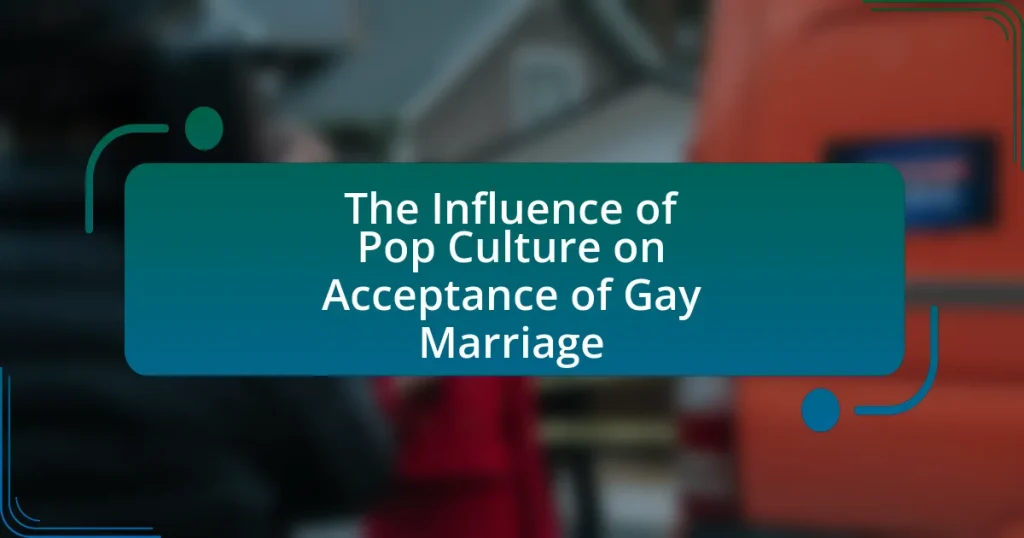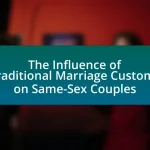The article examines the significant influence of pop culture on the acceptance of gay marriage, highlighting how media representation of LGBTQ+ relationships in television, film, and music normalizes these identities and fosters societal acceptance. Key examples include the impact of shows like “Will & Grace” and films such as “Moonlight,” which have contributed to shifting public perceptions and increasing support for same-sex marriage. The article also discusses the role of celebrities in advocacy, the mechanisms through which pop culture shapes attitudes, and the ongoing challenges in representation, ultimately emphasizing the importance of inclusive storytelling in promoting acceptance of gay marriage.
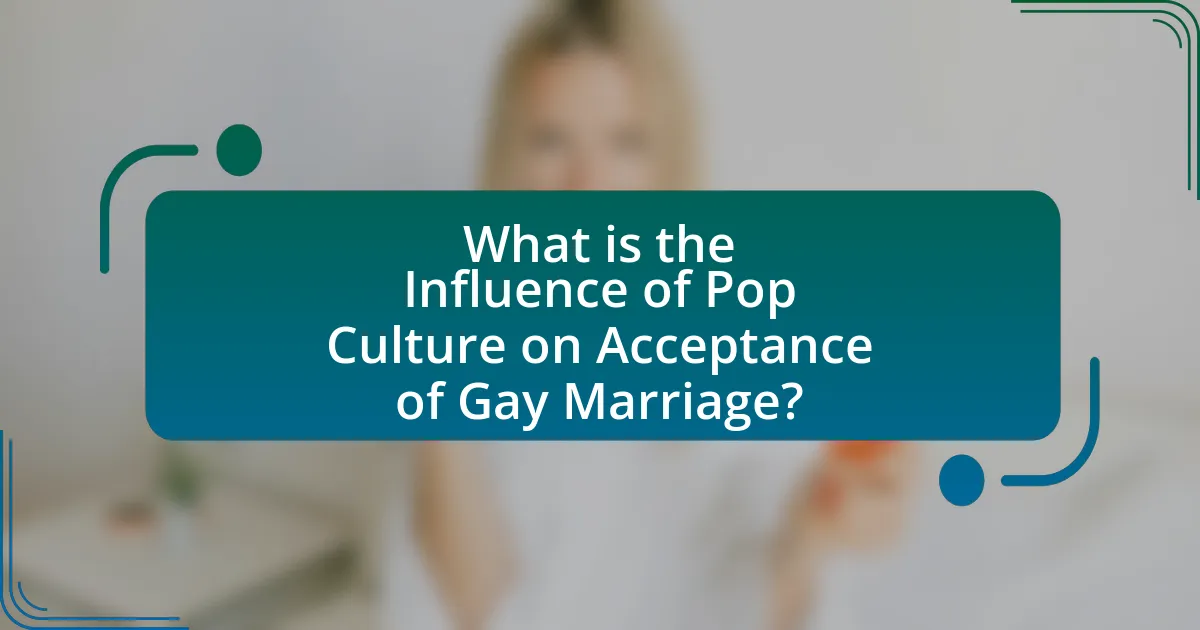
What is the Influence of Pop Culture on Acceptance of Gay Marriage?
Pop culture significantly influences the acceptance of gay marriage by normalizing LGBTQ+ relationships through media representation. Television shows, films, and music that feature gay characters and storylines contribute to greater visibility and understanding, which can shift public perceptions. For instance, the portrayal of same-sex couples in popular series like “Modern Family” and “Will & Grace” has been linked to increased support for gay marriage, as evidenced by a 2013 study published in the journal “Public Opinion Quarterly,” which found that exposure to positive representations of LGBTQ+ individuals in media correlated with more favorable attitudes toward same-sex marriage. This normalization process helps reduce stigma and fosters a more inclusive societal attitude towards LGBTQ+ rights.
How has pop culture historically shaped societal views on gay marriage?
Pop culture has historically shaped societal views on gay marriage by normalizing LGBTQ+ relationships through media representation and advocacy. Television shows like “Will & Grace,” which premiered in 1998, played a significant role in humanizing gay characters and fostering acceptance, contributing to a shift in public perception. Additionally, films such as “Brokeback Mountain” (2005) brought attention to the struggles of gay relationships, influencing discussions around marriage equality. These cultural representations have been linked to increased support for gay marriage, as evidenced by a 2015 Gallup poll showing that support for same-sex marriage rose from 27% in 1996 to 60% in 2015, coinciding with the rise of LGBTQ+ visibility in pop culture.
What key moments in pop culture have influenced perceptions of gay marriage?
Key moments in pop culture that have influenced perceptions of gay marriage include the television show “Will & Grace,” which debuted in 1998 and normalized gay relationships for mainstream audiences, contributing to increased acceptance. Additionally, the 2015 Supreme Court ruling in Obergefell v. Hodges, which legalized same-sex marriage nationwide, was widely celebrated in media, including social media campaigns and public figures expressing support, further shaping public opinion. The portrayal of LGBTQ+ characters in films like “Moonlight,” which won the Academy Award for Best Picture in 2017, also played a significant role in fostering empathy and understanding towards gay marriage. These cultural milestones collectively shifted societal attitudes, making acceptance of gay marriage more prevalent.
How do media representations of LGBTQ+ relationships affect public opinion?
Media representations of LGBTQ+ relationships significantly shape public opinion by normalizing these relationships and fostering acceptance. Research indicates that positive portrayals in television and film can lead to increased support for LGBTQ+ rights, including same-sex marriage. For instance, a study published in the Journal of Homosexuality found that exposure to LGBTQ+ characters in popular media correlates with more favorable attitudes towards LGBTQ+ individuals and issues. This effect is particularly pronounced among younger audiences, who are more likely to embrace diverse representations. Thus, media serves as a powerful tool in influencing societal norms and attitudes towards LGBTQ+ relationships.
Why is pop culture a significant factor in the acceptance of gay marriage?
Pop culture is a significant factor in the acceptance of gay marriage because it shapes societal norms and influences public perception through representation and visibility. Media portrayals of LGBTQ+ relationships in television shows, movies, and music have contributed to normalizing these relationships, making them more relatable and accepted by broader audiences. For instance, the television series “Will & Grace,” which aired in the late 1990s, played a crucial role in changing attitudes towards gay individuals, leading to increased support for gay marriage. Research from the Williams Institute indicates that positive media representation correlates with greater acceptance of LGBTQ+ rights, including marriage equality. Thus, pop culture serves as a powerful tool in fostering understanding and acceptance of gay marriage within society.
What role do celebrities play in advocating for gay marriage acceptance?
Celebrities play a significant role in advocating for gay marriage acceptance by leveraging their visibility and influence to shape public opinion. Their endorsements and public statements often reach millions, creating a platform for dialogue and awareness around LGBTQ+ rights. For instance, high-profile figures like Ellen DeGeneres and Neil Patrick Harris have openly supported gay marriage, contributing to a cultural shift that normalizes and promotes acceptance. Research indicates that celebrity endorsements can increase public support for social issues; a study published in the Journal of Social Issues found that celebrities can effectively reduce stigma and foster acceptance through their advocacy efforts.
How do popular films and television shows contribute to changing attitudes?
Popular films and television shows contribute to changing attitudes by portraying diverse characters and narratives that challenge societal norms. For instance, shows like “Will & Grace” and films such as “Moonlight” have humanized LGBTQ+ experiences, fostering empathy and understanding among viewers. Research indicates that exposure to positive representations of gay relationships in media correlates with increased acceptance of gay marriage; a study published in the Journal of Homosexuality found that individuals who consumed LGBTQ+ inclusive media were more likely to support same-sex marriage legislation. This demonstrates that popular culture plays a significant role in shaping public perceptions and attitudes towards LGBTQ+ rights.
What are the mechanisms through which pop culture influences acceptance?
Pop culture influences acceptance through representation, normalization, and emotional connection. Representation in media, such as television shows and films featuring LGBTQ+ characters, allows audiences to see diverse identities reflected in their everyday lives, fostering empathy and understanding. Normalization occurs when these representations become commonplace, reducing stigma and making acceptance more likely; for instance, the portrayal of same-sex couples in popular series has contributed to shifting societal attitudes. Emotional connection is established through storytelling that resonates with viewers, creating a sense of shared experience and humanity, which can lead to increased acceptance of gay marriage. Studies, such as those conducted by the Williams Institute, show that exposure to positive LGBTQ+ representations correlates with greater support for same-sex marriage rights.
How does social media amplify messages related to gay marriage?
Social media amplifies messages related to gay marriage by providing a platform for widespread sharing and engagement, allowing individuals and organizations to reach large audiences quickly. For instance, campaigns like the Human Rights Campaign’s “Love Conquers Hate” utilized platforms such as Facebook and Twitter to mobilize support, resulting in millions of shares and interactions that raised awareness and fostered community discussions. Additionally, studies show that social media can influence public opinion; a 2015 Pew Research Center report indicated that 72% of social media users encountered content about same-sex marriage, which contributed to shifting attitudes toward acceptance.
What impact do music and art have on the discourse surrounding gay marriage?
Music and art significantly influence the discourse surrounding gay marriage by shaping public perceptions and fostering acceptance. For instance, songs like “Same Love” by Macklemore and Ryan Lewis have directly addressed LGBTQ+ rights, contributing to increased visibility and support for gay marriage. Additionally, visual art, such as the works of artists like Keith Haring, has historically advocated for LGBTQ+ issues, creating a cultural dialogue that challenges societal norms. Research indicates that exposure to LGBTQ+ themes in popular culture correlates with more favorable attitudes toward gay marriage, as evidenced by a 2015 study published in the Journal of Homosexuality, which found that media representation positively impacts public opinion. Thus, music and art serve as powerful tools in advancing the conversation and acceptance of gay marriage.
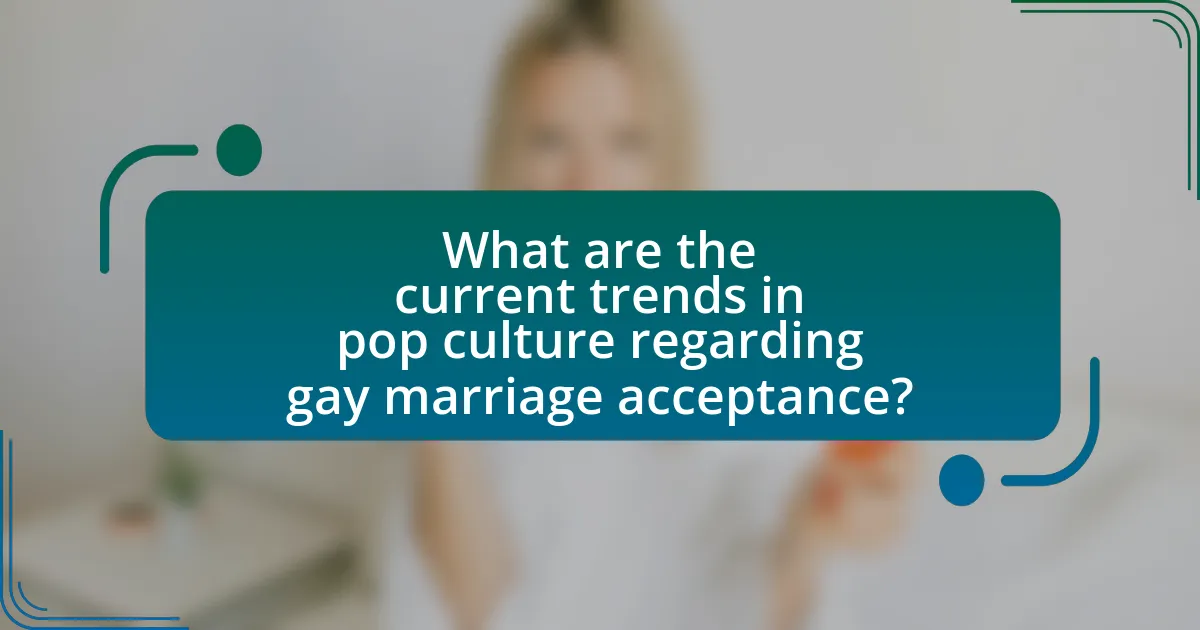
What are the current trends in pop culture regarding gay marriage acceptance?
Current trends in pop culture indicate a strong acceptance of gay marriage, reflected in media representation, celebrity advocacy, and public events. Television shows and films increasingly feature LGBTQ+ characters and storylines that normalize same-sex relationships, contributing to societal acceptance. For instance, shows like “Pose” and “Schitt’s Creek” have received critical acclaim for their portrayal of LGBTQ+ narratives, influencing public perception positively. Additionally, high-profile celebrities openly supporting gay marriage, such as Ellen DeGeneres and Lil Nas X, amplify acceptance through their platforms. According to a 2021 Gallup poll, 70% of Americans support same-sex marriage, showcasing a significant cultural shift influenced by these pop culture trends.
How are contemporary artists and creators addressing gay marriage in their work?
Contemporary artists and creators are addressing gay marriage through various mediums, including visual art, film, music, and literature, often highlighting themes of love, equality, and social justice. For instance, artists like David Hockney and Kehinde Wiley have created works that celebrate LGBTQ+ relationships, while filmmakers such as Barry Jenkins in “Moonlight” explore the complexities of identity and love within the gay community. Additionally, musicians like Sam Smith and Lil Nas X use their platforms to advocate for LGBTQ+ rights and acceptance, often incorporating personal narratives about their experiences with love and marriage. This artistic engagement not only reflects societal changes but also contributes to the ongoing dialogue surrounding the acceptance of gay marriage, as evidenced by the increased visibility and representation of LGBTQ+ themes in mainstream culture.
What themes are prevalent in recent films and shows about gay marriage?
Recent films and shows about gay marriage frequently explore themes of love, acceptance, and the struggle for equality. These narratives often highlight the personal journeys of LGBTQ+ couples as they navigate societal challenges and familial acceptance, reflecting broader societal shifts towards inclusivity. For instance, films like “Love, Simon” and shows such as “Schitt’s Creek” emphasize the importance of love transcending societal norms, while also addressing the legal and emotional hurdles faced by same-sex couples. This thematic focus not only mirrors the ongoing discourse surrounding gay marriage but also contributes to the normalization and acceptance of LGBTQ+ relationships in mainstream culture.
How do current events in pop culture reflect changes in societal acceptance?
Current events in pop culture reflect changes in societal acceptance by showcasing diverse representations and narratives that challenge traditional norms. For instance, the increasing visibility of LGBTQ+ characters in mainstream media, such as in popular television shows like “Pose” and “Schitt’s Creek,” illustrates a shift towards greater acceptance of gay marriage and LGBTQ+ rights. According to a 2021 GLAAD report, 20% of characters on scripted television were LGBTQ+, a significant increase from previous years, indicating a broader societal embrace of these identities. This representation not only normalizes LGBTQ+ relationships but also influences public opinion, as studies show that exposure to diverse narratives can lead to increased acceptance and support for policies like gay marriage.
What challenges remain in the portrayal of gay marriage in pop culture?
Challenges in the portrayal of gay marriage in pop culture include persistent stereotypes, limited representation, and backlash from conservative groups. Stereotypes often reduce LGBTQ+ characters to one-dimensional roles, which can perpetuate misconceptions and hinder authentic narratives. Limited representation is evident in the underrepresentation of diverse LGBTQ+ experiences, particularly among people of color and transgender individuals, which fails to reflect the true spectrum of the community. Additionally, backlash from conservative groups can lead to censorship or negative portrayals, impacting the overall acceptance and normalization of gay marriage in mainstream media. These challenges highlight the ongoing need for more nuanced and inclusive storytelling in pop culture to foster greater understanding and acceptance of gay marriage.
What stereotypes persist in media representations of LGBTQ+ relationships?
Stereotypes that persist in media representations of LGBTQ+ relationships include the portrayal of gay men as overly flamboyant and effeminate, while lesbian relationships are often depicted as hypersexualized or male-gaze oriented. These stereotypes reinforce narrow and unrealistic views of LGBTQ+ identities. Research indicates that such representations can lead to societal misconceptions, as evidenced by a study published in the Journal of Homosexuality, which found that media portrayals significantly influence public perceptions of LGBTQ+ individuals and relationships.
How do backlash and resistance manifest in pop culture narratives?
Backlash and resistance in pop culture narratives often manifest through the portrayal of negative stereotypes, counter-narratives, and public controversies surrounding LGBTQ+ representation. For instance, films and television shows may depict gay characters in a derogatory manner or reinforce traditional gender roles, which can provoke public outcry and calls for more authentic representation. A notable example is the backlash against the portrayal of gay characters in the early 2000s, where shows like “Will & Grace” faced criticism for not fully representing the diversity of the LGBTQ+ community. This resistance can also lead to the emergence of alternative narratives that challenge mainstream depictions, such as the rise of independent films and series that present more nuanced and varied stories about gay relationships, contributing to a broader acceptance of gay marriage in society.
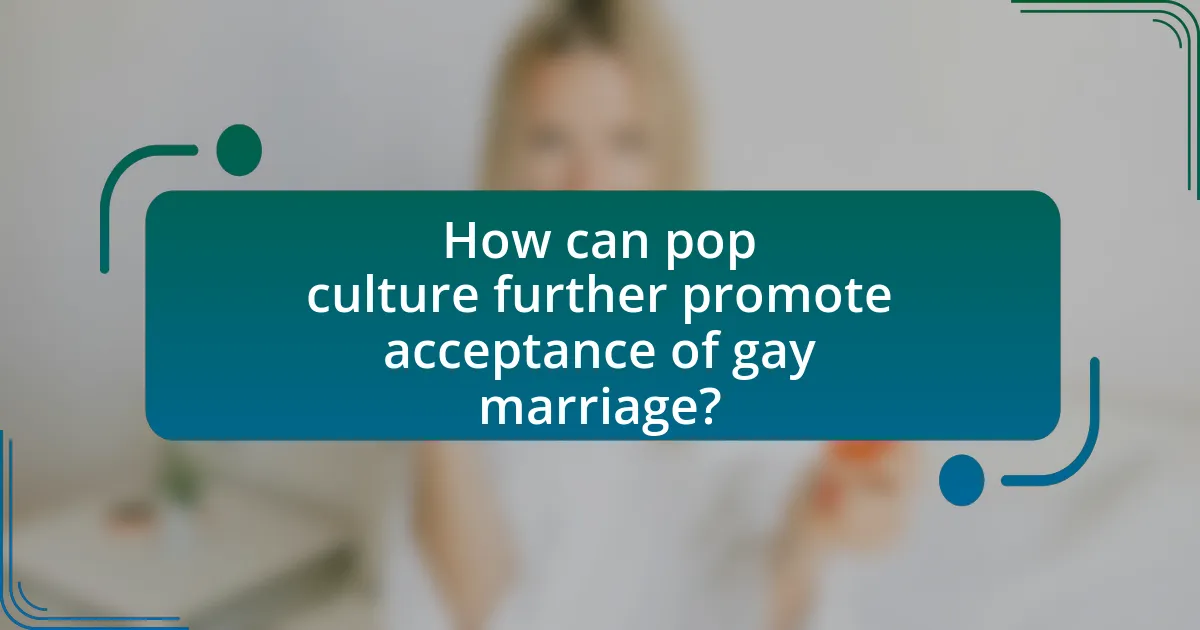
How can pop culture further promote acceptance of gay marriage?
Pop culture can further promote acceptance of gay marriage by increasing visibility and representation of LGBTQ+ relationships in mainstream media. This visibility normalizes same-sex relationships and challenges stereotypes, as evidenced by the success of television shows like “Modern Family” and “Pose,” which feature gay couples and LGBTQ+ narratives. Research indicates that exposure to positive portrayals of LGBTQ+ individuals in media correlates with greater acceptance among viewers, as shown in a study published in the Journal of Homosexuality, which found that individuals who consumed LGBTQ+ media were more likely to support same-sex marriage. By continuing to showcase diverse LGBTQ+ stories, pop culture can foster empathy and understanding, ultimately leading to broader societal acceptance of gay marriage.
What strategies can creators use to foster positive representations of gay marriage?
Creators can foster positive representations of gay marriage by showcasing diverse and authentic narratives that reflect the experiences of LGBTQ+ individuals. By including characters in various media who are in loving, committed same-sex relationships, creators can normalize these representations and challenge stereotypes. Research indicates that positive portrayals in television and film can significantly influence public attitudes; for example, a study by the Williams Institute found that exposure to LGBTQ+ characters in popular media correlates with increased acceptance of gay marriage among viewers. Additionally, creators can collaborate with LGBTQ+ writers and consultants to ensure authenticity and depth in storytelling, further enhancing the positive impact of their work.
How can inclusive storytelling impact audience perceptions?
Inclusive storytelling can significantly enhance audience perceptions by fostering empathy and understanding towards diverse experiences. When narratives include varied perspectives, particularly those of marginalized groups, they challenge stereotypes and promote acceptance. Research indicates that exposure to inclusive media can lead to more positive attitudes towards LGBTQ+ individuals; for instance, a study published in the Journal of Homosexuality found that viewers of inclusive television shows reported increased support for gay marriage. This demonstrates that inclusive storytelling not only reflects societal diversity but also actively shapes audience beliefs and attitudes, contributing to greater social acceptance.
What role can educational initiatives in pop culture play in promoting acceptance?
Educational initiatives in pop culture play a crucial role in promoting acceptance by providing accessible information and fostering empathy through relatable narratives. These initiatives, such as inclusive media representations and educational campaigns, help to normalize diverse identities and experiences, making them more visible and understood. For instance, television shows like “Modern Family” and films like “Moonlight” have contributed to shifting public perceptions by portraying LGBTQ+ characters in complex, humanizing ways, which research indicates can lead to increased acceptance and support for gay marriage. Studies show that exposure to positive representations in media correlates with greater acceptance of LGBTQ+ rights, highlighting the effectiveness of educational initiatives in shaping societal attitudes.
What practical steps can individuals take to support gay marriage acceptance through pop culture?
Individuals can support gay marriage acceptance through pop culture by actively promoting and engaging with LGBTQ+ representation in media. This can be achieved by sharing and discussing films, television shows, music, and literature that feature LGBTQ+ characters and storylines, thereby normalizing these narratives in everyday conversations. Research indicates that increased visibility of LGBTQ+ individuals in media correlates with greater societal acceptance; for instance, a study by the Williams Institute found that positive portrayals of LGBTQ+ characters can significantly influence public attitudes towards same-sex marriage. Additionally, individuals can participate in or support events like Pride parades and LGBTQ+ film festivals, which celebrate and elevate queer voices in the arts. By doing so, they contribute to a cultural environment that fosters acceptance and understanding of gay marriage.
How can audiences engage with and support LGBTQ+ content creators?
Audiences can engage with and support LGBTQ+ content creators by actively consuming, sharing, and promoting their work across various platforms. This engagement can include following creators on social media, participating in discussions about their content, and amplifying their messages to wider audiences. Research indicates that visibility and support from audiences can significantly impact the success and sustainability of LGBTQ+ creators, as evidenced by a 2021 study from GLAAD which found that 80% of LGBTQ+ individuals feel more empowered when they see representation in media. Additionally, audiences can provide financial support through platforms like Patreon or by purchasing merchandise, which directly contributes to the creators’ ability to produce more content.
What actions can fans take to advocate for more inclusive media representations?
Fans can advocate for more inclusive media representations by actively supporting and promoting diverse content creators and projects. This can be achieved through social media campaigns that highlight underrepresented voices, participating in discussions that challenge stereotypes, and organizing or attending events that celebrate inclusivity in media. Research indicates that increased visibility of LGBTQ+ characters and stories in popular media correlates with greater societal acceptance of gay marriage, as seen in studies by the Williams Institute, which found that representation positively influences public attitudes. By engaging in these actions, fans can contribute to a cultural shift towards more inclusive narratives.
